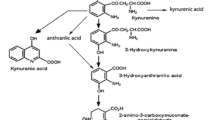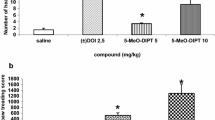Abstract
Probenecid was administered orally in a dose of 1 g twice daily for 3 days to eight patients nutriated through a gastric tube with a standarized diet containing a known amount of tryptophan. Probenecid caused an increase by 52% (P<0.01) in the free (non protein-bound) concentration of tryptophan in plasma (from 1.22±0.16 to 1.86±0,28 Μg/ml; mean±SEM). The total (free + protein-bound) plasma tryptophan concentration was not significantly changed by the present dose of probenecid. There was a positive correlation (Spearmans rank correlation coefficient =0.74; P<0.05) between the increase in percentage free tryptophan and the achieved plasma concentration of probenecid. The cerebrospinal fluid (CSF) concentration of tryptophan was not significantly changed by probenecid (2 g/day during 21/2 days) given to another group of five patients.
It is concluded from the present study, that the increase in the CSF concentration of 5-hydroxyindoleacetic acid (5-HIAA) caused by probenecid, in addition to blockade of the 5-HIAA transport out of the CSF, might be explained by an increased rate of synthesis of brain serotonin since the availability of its precursor is increased due to the probenecid-induced increase in the plasma concentration of free tryptophan.
Similar content being viewed by others
References
Ashcroft, G. W., Dow, R. C., Moir, A. T. B.: The active transport of 5-hydroxyindole-3 ylacetic acid 3-methoxy-4-hydroxyphenylaeetic acid from a recirculatory perfusion system of the cerebral ventricles of the ananaesthetized dog. Brit. J. Pharmacol. 33, 457–471 (1968)
Denckla, W. D., Dewey, H. K.: The determination of tryptophan in plasma, liver and urine. J. Lab. clin. Med. 69, 160 (1967)
Fernström, J. D., Wurtman, R. J.: Brain serotonin content: Physiological dependence on plasma tryptophan levels. Science 173, 149–152 (1971)
Fernström, J. D., Wurtman, R. J.: Brain serotonin content: Physiological regulation by plasma neutral ammo acids. Science 178, 414–416 (1972)
Friedman, P. A., Kappelman, A. H., Kaufman, S.: Partial purification and characterization of tryptophan hydroxylase from rabbit hindbrain. J. biol. Chem. 247, 4165–4173 (1972)
Geddes, C., Moir, A. T. B.: The removal of L-tryptophan from cerebrospinal fluid in the dog. Brit. J. Pharmacol. 36, 204–205 P (1969)
Grahame-Smith, D. G.: Studies in vivo on the relationship between brain tryptophan, brain 5-HT synthesis and hyperactivity in rats treated with monoamine oxidase inhibitor and L-tryptophan. J. Neurochem. 18, 1053–1066 (1971)
Guarino, A. M., Conway, W. D., Fales, H. M.: Mass-spectral identification of probeneoid metabolites in rat bile. Europ. J. Pharmacol. 8, 244–252 (1969)
Guldberg, H. C., Ashcroft, G. W., Crawford, T. B. B.: Concentrations of 5-hydroxyindoleacetic acid and homovanillic acid in the cerebrospinal fluid of the dog before and during treatment with probenecid. Life Sci. 5, 1571–1575 (1965)
Korf, J., van Praag, H. M., Sebens, J. B.: Serum tryptophan decreased, brain tryptophan increased and brain serotonin synthesis unchanged after probenecid loading. Brain Res. 42, 239–242 (1972)
McArthur, J. N., Dawkins, P. D.: The effect of sodium salicylate on the binding of L-tryptophan to serum proteins. J. Pharm. Pharmacol. 21, 744–750 (1969)
McArthur, J. N., Dawkins, P. D., Smith, N. J. H.: The displacement of L-tryptophan and dipeptides from bovine albumin in vitro and from human plasma in vivo by antirheumatic drugs. J. Pharm. Pharmacol. 23, 393–398 (1971)
McMenamy, R. H., Oncley, J. L.: The specific binding of L-tryptophan to serum albumin. J. biol. Chem. 233, 1436–1447 (1958)
Moir, A. T. V.: Interaction in the cerebral metabolism of the biogenic amines: Effect of intravenous infusion of L-tryptophan on the metabolism of dopamine and 5-hydroxyindoles in brain and cerebrospinal fluid. Brit. J. Pharmacol. 43, 715–723 (1971)
Olsson, R., Roos, B.-E.: 5-hydroxyindoleacetic acid and homovanillic acid levels in the cerebrospinal fluid after probenecid treatment in patients with Parkinson's syndrome. Nature (Lond.) 219, 502–503 (1968)
Perel, J. M., Cunningham, R. F., Fales, H. M.: Identification and renal excretion of probenecid metabolites in man. Life Sci. 9, 1337–1343 (1970)
Roos, B.-E.: Metabolites of the monoamines in the cerebrospinal fluid. In: Monoamines et noyaux gris ceratraux, Symposium at Bel Air IV, Geneva 1970
Sjöström, R.: Steady-state levels of probenecid and their relation to acid monoamine metabolites in human cerebrospinal fluid. Psychopharmacologia (Berl.) 25, 96–100 (1972)
Tagliamonte, A., Tagliamonte, P., Perez-Cruet, J., Stern, S., Gessa, G.: Effect of psychotropic drugs on tryptophan concentration in the rat brain. J. Pharmacol. exp. Ther. 177, 475–480 (1971)
Author information
Authors and Affiliations
Rights and permissions
About this article
Cite this article
Lewander, T., Sjöström, R. Increase in the plasma concentration of free tryptophan caused by probenecid in humans. Psychopharmacologia 33, 81–86 (1973). https://doi.org/10.1007/BF00428795
Received:
Issue Date:
DOI: https://doi.org/10.1007/BF00428795




